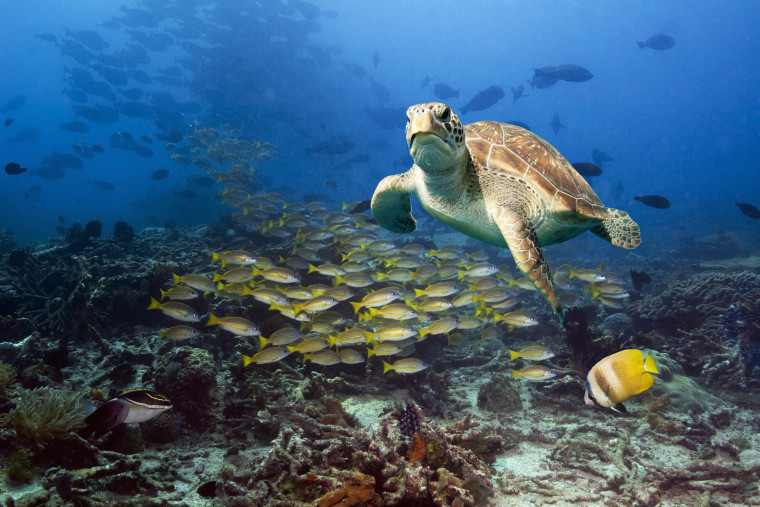Marine animals could die off at a level rivaling the biggest mass extinctions in geologic history if people don’t curb greenhouse gas emissions.
That’s the takeaway from a study published Thursday in the journal Science, which found that many ocean creatures could face conditions too warm and with too little oxygen to survive if we don't turn things around. The more warming, the fewer species are likely to survive, the results show.
The new analysis applies what the research team previously learned about the "Great Dying" 252 million years ago — when more than two-thirds of all marine life in the Permian Period went extinct — as well as other historic extinctions to today’s climate projections. Under a high emissions scenario, the results were disturbing.
"If we don’t act to curb emissions, that extinction is quite high. It registers on the geological scale among the major biotic collapses of diversity in the Earth’s history," said Curtis Deutsch, an author of the paper and a professor of geosciences at Princeton University.
The new models suggest Earth could approach Permian levels of marine extinction by 2300 if emissions continue to increase. As temperatures rise, according to the research, species richness will decline near the tropics, with some animals migrating toward higher latitudes. Polar species are most at risk, as their habitat becomes a "disappearing climate niche," the paper explains.
But that fate is far from sealed. If emissions stay near the levels world leaders set in the 2015 Paris Agreement, marine animals would fare far better, the study says.
"Extinctions are largely avoided" under that scenario, said Justin Penn, a postdoctoral researcher at Princeton who co-authored the study.
Still, the analysis is a reminder that the pace of change on Earth today may be comparable to the most extreme events in history.
"In the next few decades, we're determining if we’re really going to go deep into a mass extinction again — because of us, because of what we’re doing," said Eric Galbraith, a professor at McGill University studying human and Earth system dynamics, who was not involved in the new study. "It’s hard to wrap our heads around the importance of what we choose to do as a species in the coming decades."
Previous work from the team behind the new analysis revealed runaway global warming and a loss of oxygen in the ocean to be the causes of the Great Dying. Their model’s results matched patterns paleontologists had observed in Permian fossil records, giving it credibility.
The revelation that extreme changes to the climate were the likely causes "was a real eureka moment," Deutsch said.
Before that die-off, there was only one landmass — Pangea — and the Permian ocean teemed with marine creatures. Scientists think these animals had similar traits, like metabolisms and oxygen needs, as those today.
Scientists knew from prior studies of fossilized teeth that surface temperatures during this period soared about 10 degrees Celsius in the tropics, leading many sea animals to go extinct. The researchers suspected volcanic eruptions triggered the changes, so they modeled those conditions.
The results showed that many species were pushed past their physiological limits.
As the climate warmed, animals needed more oxygen to perform bodily functions like breathing. But warmer water doesn’t contain as much dissolved oxygen — which made it more difficult for species to survive.
"Imagine facing inflation while your hours are also being cut or your salary is going down," Deutsch said. "The ocean is giving less oxygen to organisms in spite of the fact they have this inflationary need."
A similar process is happening now, Penn said: "The Permian event was caused by climate warming and ocean oxygen loss — two environmental changes underway today."
The question driving Deutsch and his colleagues’ latest research was "how much of the same phenomenon would manifest" in Earth’s future.
They found stark differences depending on how much warming takes place. Extinctions grow at a linear rate in the model as temperatures increase, Deutsch said.
"There’s a strong sentiment out there, probably among some of your readers and viewers: 'It's too late or the window is closed,'" he said. "That’s not what our results show."
Currently, the world’s average surface temperatures are on pace to rise roughly 3.2 degrees Celsius (5.8 degrees Fahrenheit) by the end of the century relative to preindustrial times. But limiting global warming to 2 degrees Celsius — a goal agreed to in the Paris accord — would lower the severity of extinctions by more than 70 percent, the paper found.
"There’s still time to conserve the diversity that evolution has gradually built up in the ocean," Deutsch said.
However, if emissions continue to increase, nations remain divided on climate goals and temperatures soar by nearly 5 degrees Celsius by century’s end, marine biodiversity would start to trend toward rates observed in previous mass extinctions.
Galbraith said the research relied on "mature" models, with conclusions based on simple, "reliable" equations.
"I hope this is a fairy tale — these terrible impacts on the marine ecosystem," he said. "It's just a question of building new infrastructure that gets us off fossil fuel infrastructure. We should be able to do that in the next couple decades."
Galbraith added that the future of ocean life also depends on addressing other harmful human activity, such as intensive fishing or pollution, that could cause cascading effects in combination with climate change.
“This is really just looking at one dimension of pressure,” he said.
